Vacuum infusion, an introduction
Vacuum infusion, also named resin infusion, from what I could find about it, seemed to me the ultimate way of laminating boat hulls for my one-off trimaran. I saw the possibilities to make my single handed boatbuilding project possible without having any previous composite experience. After all, vacuum infusion is a defined process that not depends of my initially lack on knowledge and experience and skills for laminating big boat hulls.
Vacuum bagging is much more tolerant and can operate even with a not leak proof vacuum bag and at lower vacuum rates, so must be much easier to do. However, being not a defined process, requires experience and skills in the eyes of this novice composite worker because it has to start with a hand-lay-up laminate with all the accompanying tits and bits. At least that was my thought at the start of the project Fram.
For the experienced composite worker it is a piece of cake and is the text above just BS. For the beginner in composites with a high tech composite yacht in mind, the choice for vacuum infusion is a logical one. Just acquire the knowledge and go for it ......
Note: After many years of experience with both methods, I was able to make a comparison between the vacuum bagging and vacuum infusion. See the relevant chapter at the bottom of this page.

Clean dry or sticky wet laminating
When I lose myself in the various laminating aspects, I find out that there are some tricky and sticky moments in fabricating the composite parts, concerning:
1. Health

I prefer to use Epoxy instead of Polyester or Vinylester resins. Besides of the smell (styrene), which will cause a nuisance to my family (our garage is the workshop) and neighbors, epoxy resins are far superior. I have been working with epoxy for almost 25 years now (writing this in 2000) and I am still healthy yet. I want to keep it this way, as developing an epoxy allergy is still one of the dangers.
Here are some quotes from other builders
who has been less lucky :-( So, a minimal exposure to epoxy is desirable.2. Quality
I can have sleepless nights about delaminating of the several layers and the foam core (I myself having a wooden hart, a metal boat and a prejudgment against ″Tupperware″ yachts). The bonding between the fabrics itself and to the foam core is mechanical and not chemical. I want to be my ship stiff, also after extensive use. I don't like a boat falling apart after a heavy weather passage! As for this bonding as for the reinforcement structure it's very important that there is no capture of air.
Voids in the laminate accelerate delamination and weaken the structure. That's why compressing the laminate under a vacuum is a preferable technique, for a better laminate, without voids, dry spots or resin rich spots, a good bonding between the glass layers and the foam core and a better control of the glass to resin ratio.
 The process makes the structure lighter, stiffer and stronger. I don't like secondary bonding and want to make large and complicated structures in one shot.
The process makes the structure lighter, stiffer and stronger. I don't like secondary bonding and want to make large and complicated structures in one shot.
3. Weight
I aim for an optimum quality, but also an optimum lightweight. I'm not that kind of racer, well, maybe sometimes, but the lighter the boat the more cruising stuff you can carry with you (still learning to get out of this bad habit). The designer has reckoned a safety margin for structural integrity and the builder have to have confidence in this. But in practice the boat builder tend to built stronger as needed and it is often quite difficult to keep in check with this tendency. Instead of building heavier, I want to find an extra margin in a save and accurate building method and in the same time obey to my uncertainty and the (probably unnecessary) need for extra strength without making concessions to the desired lightweight construction.

Mold or no mold ?
A successful infusion is only possible in an air-tight mold where - at least in the method described here - the top is composed of an airtight plastic film that is connected to a flange of the mold. Professional yacht construction uses molds to build the yacht hulls in series. For a one-off project that is not convenient, unless unlimited budget and manpower is available.
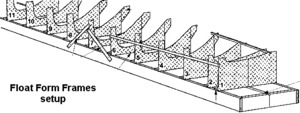
The hull of my boat consists of a sandwich of laminate and corecell foam that is put together in a building frame. So why not use that as a mold ? Despite the negative advice from designer and supplier, I went on to investigate this further. They said it had been tried before but failed. My vendor advised me to first apply a thin layer of 200 grams fiber with hand-lay-up and thus form an airtight surface. But that already means more than 30% of the required laminate on the inside of the hull, not in my way of thinking !
Corecell foam in the 15mm thickness that I use is already airtight from itself (tested by myself) So it's the seams between the different parts that need extra attention. So it must be possible to use the bare foam as a mold for my vacuum infusion plans.
At the same time of my considerations, Ian Farrier introduced the vertical strip method, whereby the foam is not applied in narrow longitudinal strips, but in much wider vertical strips. It requires thermoforming of the foam, which is not needed with the longitudinal method (here in NL known as "woodcore method" but then with the use of foam instead of wood). Despite the fact that fewer frames are needed, it requires a little more work on the frames by adding longitudinal wooden slats to support the vertical foam strips. But vertical stripping dramatically reduces the number of interconnections in the foam. I can then realize the extra attention for the seams by milling them open and filling them with thickened epoxy. An additional advantage is the clean process which does not require the use of sticky glue during the assembly of the foam. The flange which is required to be able to attach the vacuum film can then be realized simply by cutting the foam a little longer (10 cm) than strictly needed for the hull.

Controlled Vacuum Infusion

VIP = Vacuum Infusion Process, VARTM = Vacuum Assisted Resin Transfer Molding, RI = Resin Infusion, SCRIMP = Seeman Composites Resin Infusion Molding Process, CVI - Controlled Vacuum Infusion, all these terms are covering basically the same technique. The basic idea is simple: lay the reinforcements materials up dry, compact them under vacuum, and then use the vacuum to pull the resin in from outside the bag (or mold) which subsequently progresses through the dry layup.
In the professional building environment this is a promising technology for the production of large, high-quality, composite parts. This technique uses one atmosphere of vacuum pressure to drive resin into a laminate. The reinforcement materials are laid dry and the vacuum is applied before resin is introduced. Once a complete vacuum is achieved, resin is literally sucked into the laminate via carefully placed tubing. This process adds improved worker conditions, emissions reduced to almost nothing and considerable savings on labor costs.
Another big advantage is that you can take your time for laying out all of the laminations of glass and foam in a dry environment and not under the pressure of a curing resin. When it is all ready you can take the time to bag it and check it for leakage. After everything is fine and checked, infuse it at your leisure, the same day, next week or at any other moment. The only time you will even need to wear gloves is while mixing the resin. No rollers, brushes or mess to clean up afterwards. No epoxy fumes from a large wet area.
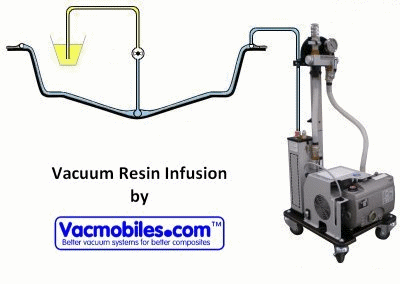
The vacuum infusion process eliminates the inconsistencies of hand lay-up that's heavily dependent on laminator's skill and it completely does away with air entrapment and void problems that can compromise durability. There are no voids that can fill with water or paths for potential water migration through the core. The process creates the highest resin-to-glass ratio in yacht construction. This is the result of a ⅓ resin to ⅔ glass fiber ratio rather than the ⅔ resin to ⅓ (or ½ to ½ at best) glass fiber used in other builder's processes. Higher glass fiber content results in greater strength to weight ratio and a lighter, yet stronger composite laminate.
However, in spite of all these advantages, general acceptance has been slow, mainly due to the high risks involved with trial-and-error methods due to just guesswork. Without a control method, all materials and labor are wasted if the chosen injection strategy does not work. Once infusion begins, there is little that can be done to correct any errors. It is very easy to destroy a part and the best protection from disaster must be careful planning. That's why most builders still stick to vacuum bagging, producing high quality panels, where the excess resin content from the wet hand-lay-up laminate is sucked by a bleeder under vacuum pressure (up to the breather/bleeder capacity). However, when larger parts are made, vacuum bagging can become quite elaborate, or even impossible.
Using Vacuum Infusion technology by a part time boat builder - which I am - in this size range is rare. But, technologies are developing fast and why should I not benefit from these advantages. I became enthusiast when I discovered this technique while successful used by the building of a one-off 44 ft. leaner, which was publiced in our local “Zeilen” magazine. The key factor in this success, and the reason why I am able to use resin infusion for building my boat, is the use of a very specialized software program, RTM-Worx, and the accompanying advice by the developer of this software Mr. Arjen Korevaar from Polyworx. The term “controlled“ made it all possible for me as an amateur, together with the steep learning curve provided by Polyworx.

Flow simulation software
The flow simulation software makes it possible to eliminate the guesswork. Injection strategies that do not work are quickly eliminated and new ways to infuse parts can be tried out without any risks. It is not necessary to do costly trials and no labor or materials are wasted with the capability to test it on the PC first. The simulation code is based on the Finite Element and Control Volume methods to solve the physical equations that govern flow of a resin through a porous medium.
When CAD-files are available it is possible to import 3D models from STL, DXF and PATRAN files. However, the availability can be a problem due to copyright, license and or confidential aspects. Most designers are uncomfortable supplying these CAD files - the America's cup guys even get upset if someone looks at their hull through binoculars. As Mr. Ian Farrier explained to me, it is like Microsoft gives away the full source code of windows.
The RTM-Worx software however is also equipped with an integrated geometry editor. With this function you can enter your own 3D model.
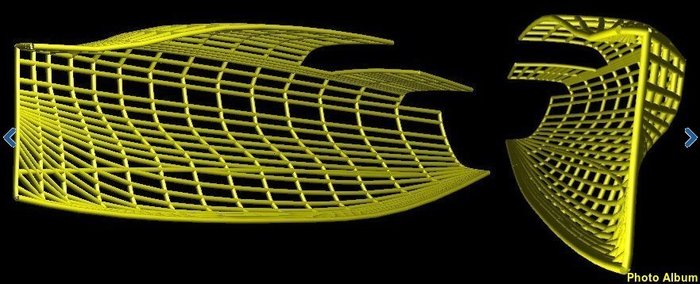
It took me four days to digitalize the Full Size Patterns of the F-39 to an enough accurate 3D model. So I provide the station lines in the Full Size Patterns with diagonal lines and thus created a three-dimensional grid. I entered the corresponding digits -easily obtained by measuring by hand- in RTM-Worx and joined this key points with curves, et voila.... well not totally. The last imperfections or inaccuracies becomes visible in the 3D model that can be executed in thin lines or thicker tubes. It is important that all of the lines in the correct manner are connected to each other without gaps. Imperfections appear to be better seen with thicker tubes.
The next step with these models is to add runners, injection and venting ports, direction of gravity, resin and fabric properties. This is of course the tricky part that determines the infusion strategy. But in this phase it is still only the computer that performs the infusion.
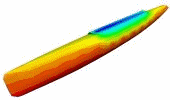
Variations in the layout of the infusion materials ensure optimal results. Checking the effects show themselves well in a controlled simulation of the infusion process. Above is an example of the calculated moving animation of the infusion process for the main hull half.
You can find more simulations and photo's and videos of the real infusion in the various project topics of floats and main hull.

Vacuum Resin Infusion Do-It-Yourself ?
The art of infusing various components can seem daunting at first. It all seems a bit complicated. However, its difficultly depends solely on the complexity of the part. For example infusing a flat sheet is simple and relatively straight forward.
I receive a lot of questions about this Resin Infusion technique, which made me thinking of a way to make this easier understandable and within practical reach for other builders. When knowing the principles and understanding of why the resin flows as it flows, it all will become much easier.
The above-mentioned explanation of controlled vacuum infusion is a great solution for complicated shapes such as a boat hull. But for infusing simple shapes as panels and bulkheads, you really don't need any software to do so, just some common sense and a way to overcome all beginners failures while doing it the right way from the beginning, without wasting expensive composite materials.
The art of infusing various components can seem daunting at first. It all seems a bit complicated. However, its difficultly depends solely on the complexity of the part. For example infusing a flat sheet is simple and relatively straight forward
Talking about bulkheads and panels, several sources are trying you to believe that vacuum infusion is more work or much slower than vacuum bagged panels.
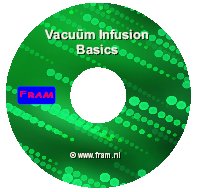
I can assure you it is not! Apart from all other benefits it's also a time safer when making bulkheads and panels. I now can produce a 4′x8′ (120x240) doublesided infused sandwich panel on my own in just three hours, including cutting the required glassfibre, peelply, releasefilm, flow mesh and vacuumfilm and using a standard pre-perforated 15mm corecell sheet. The result is a composite panel of unmatched quality, it only needs the curing time for further processing.
Anyway, you could order my Resin Infusion Starter Kit through this site for many years. This was a handy package with materials to infuse a small panel on both sides. But because I'm done with my project, I use very little infusion materials and has therefore stopped the supply for the starter kit. Although it is still possible to order the original step-by-step manuals and videos that were on the CD

Resin Infusion vs. vacuum bagging and hand-lay-up
So, how is Resin Infusion comparable to vacuum bagging and hand-lay-up. From my own experience I compare the pro's and con's in this document.
| « Previous Next » |